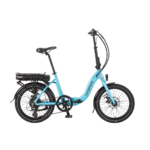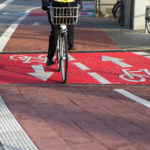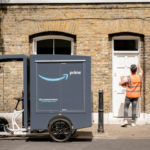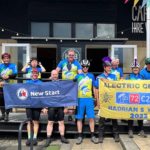Quite a lot of e-bikes now use brushless hub motors with a 3 way speed/power switch. As I understand it these modes set a top limit on motor speed. Even on single speed controllers these also set a max speed, typically the legal limit. On top of this there is also a constant current limit and a peak current limit. So this has the effect of limiting the power when the bike can't reach it's max speed due to a hill and so it's trying to draw more current than is safe for the controller, battery or motor. When there's a throttle attached as well as pedelec, the throttle seems to make the maximum speed of the motor variable up to the max for that mode. It may also vary the current limit and hence the power available. When the motor hits it's top speed for the mode, it stops providing torque usually due to the freewheel within the hub.
Ignoring legal issues for the moment. I'm wondering if it would be possible to have an alternate strategy where the modes set a power limit rather than a speed limit within a wider speed range. This range should have an upper sanity check such as 30mph. Real world power available would mean that this speed would be very rarely reached. Having a power limit would mean that the rider could set an assist level (50w or 150w, say) and then ride at whatever speed their own leg power plus 50w could achieve. On a ride with gentle gradients, I feel like this would result in slower ascents but using less power which ought to help range. And faster descents which would help A2B times.
This was all prompted by riding an Alien and finding myself switching from medium to low on ascents to use less power and get more range. And from medium to high to get the wind in my hair on descents. On the steeper ascents, the motor is trying hard to maintain it's relatively high top speed when I would have been happy to keep adding leg power and accept a slower ascent. Maybe I'm just asking for an automatic version of what I'm doing manually.
- Does this description make sense?
- Would it be sensible and/or an advantage over current controller strategies? I'm unsure of what the overall effect would be in terms of range and hill climbing ability
- Are there any controllers that work like this or can be made to work like this with the typical SB style hub motor?
I think this also opens up a different mind set. Instead of a moped that needs a bit of help from our legs, this would be a bicycle that gets a little help from the motor. This might allow a smaller, lighter hub and a smaller, lighter battery for realistic use and range. Or a battery of current size that offered a much larger range. This turns into a question that probably appears stupid. Instead of striving for 350w or 500w or more, how small and light can we make a 100w e-bike? And would the end result be frustrating or satisfying?
Back to the legal issues. This obviously opens up the ability to add power to a long downhill plus hard work from the legs to seriously break the pedelec speed limit. For the purposes of this discussion I'm really not interested. Or at least not until the same approach is applied to a faired recumbent and we're hitting 50mph.
Ignoring legal issues for the moment. I'm wondering if it would be possible to have an alternate strategy where the modes set a power limit rather than a speed limit within a wider speed range. This range should have an upper sanity check such as 30mph. Real world power available would mean that this speed would be very rarely reached. Having a power limit would mean that the rider could set an assist level (50w or 150w, say) and then ride at whatever speed their own leg power plus 50w could achieve. On a ride with gentle gradients, I feel like this would result in slower ascents but using less power which ought to help range. And faster descents which would help A2B times.
This was all prompted by riding an Alien and finding myself switching from medium to low on ascents to use less power and get more range. And from medium to high to get the wind in my hair on descents. On the steeper ascents, the motor is trying hard to maintain it's relatively high top speed when I would have been happy to keep adding leg power and accept a slower ascent. Maybe I'm just asking for an automatic version of what I'm doing manually.
- Does this description make sense?
- Would it be sensible and/or an advantage over current controller strategies? I'm unsure of what the overall effect would be in terms of range and hill climbing ability
- Are there any controllers that work like this or can be made to work like this with the typical SB style hub motor?
I think this also opens up a different mind set. Instead of a moped that needs a bit of help from our legs, this would be a bicycle that gets a little help from the motor. This might allow a smaller, lighter hub and a smaller, lighter battery for realistic use and range. Or a battery of current size that offered a much larger range. This turns into a question that probably appears stupid. Instead of striving for 350w or 500w or more, how small and light can we make a 100w e-bike? And would the end result be frustrating or satisfying?
Back to the legal issues. This obviously opens up the ability to add power to a long downhill plus hard work from the legs to seriously break the pedelec speed limit. For the purposes of this discussion I'm really not interested. Or at least not until the same approach is applied to a faired recumbent and we're hitting 50mph.






